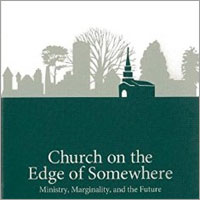Some books remind us of the church’s mission to those on the margin of life. We read them; we feel bad. Nothing changes. Other books describe the culture of congregations. They show appreciation for its layers of meaning and its setting in the community. We read them and say, “Yes, that’s how it is.” Again, nothing changes. In Church on the Edge of Somewhere, George Thompson wants to combine the biblical motivation from the first set of books and the relentless realism from the second set of books so something happens when a congregation remembers that they themselves were once strangers in Egypt.
Thompson classifies congregations into four types by their focus of attention (outward or inward) and by the social-economic status of their members (conventional or marginal). There is a next faithful step in ministry to marginal persons for the churches in all four groups.
- Inner-directed marginal churches are in a survival mode. Like the storefront churches of immigrants, they have little physical or leadership capital for reaching out to other marginal persons. It is enough for such churches to reach stability or conventionality as a precondition to having more empathy.\
- Empathetic conventional churches serve marginal persons but without expectation that the marginal persons will become part of the worship and mission of the congregation. These might be vibrant inner city churches where ministry for those in need is a badge of membership. The next step is to move from for to with.
- Empathetic marginal churches, the smallest number, move beyond obligation to help those on the margins to finding new vitality in ministry with them. Thompson points to the Church of the Savior in Washington, DC (small) and Trinity UCC in Chicago (large) as models.
- Inner-directed conventional churches are shored up by middle class members determined to promote the well-being of the congregation and its members. They have limited vision for marginal persons. Thompson places roughly 60 percent of American churches in this category. Many belong to
 denominations with declining memberships. Given the growing diversity of society and the disestablishment of religion, their future lies in moving closer to the contemporary equivalents of the
denominations with declining memberships. Given the growing diversity of society and the disestablishment of religion, their future lies in moving closer to the contemporary equivalents of the
Bible’s orphan, widow, and resident alien.
In earlier books George Thompson provides some of the tools that it would take to lead a congregation to a better ministry to and with marginal persons, tools like building congregational consensus. The special contribution of Church on the Edge of Somewhere is to help leaders and their congregations to discern what that next step in principle might be.
Church on the Edge of Somewhere can be purchased at Amazon.







